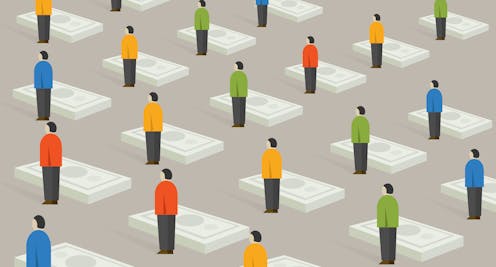
Newfoundland and Labrador recently announced plans to introduce a basic income for people aged 60-64 receiving social assistance. It is slated to roll out in April 2024 and will match existing federal seniors’ benefits.
On Prince Edward Island, a recent report has outlined how the province could reduce poverty by adopting a basic income. Meanwhile in Ottawa, the Senate is considering developing a framework for a national basic income. Momentum behind a basic income is clearly growing in Canada.
Still, some remain skeptical and reservations about basic income often come down to ideas about who truly deserves assistance.
Treating poverty as an individual problem
There are largely three explanations for poverty. First, the individual explanation points to personal failings or inadequacies (like laziness or lack of discipline) as key contributors.
Second, the structural or systemic explanation considers the societal barriers that cause poverty: the lack of quality jobs, inequality, climate disruptions and economic and health crises, among other issues.
Third, the fatalistic explanation suggests that how people fare in life really chalks up to fate (hence the “less fortunate” label), bad luck causes unfortunate events, like illness or loss, that trigger poverty.
Of these, the second has the greatest weight — the causes of poverty are systemic.
Canada’s social welfare architecture is modelled after the British and built on 16th-century poor law ideas. This legacy taught us to believe that poverty is a personal responsibility, with the onus on individuals to lift themselves out of it through discipline and hard work. Public assistance was purposefully designed to be punitive and stigmatizing so that people avoided it at all costs.
The poor were divided into two camps: the deserving poor (the infirm, elderly or disabled) were provided assistance at home, whereas the “able-bodied” undeserving poor were provided food and lodging in exchange for work in gruelling workhouses, supposedly meant to instil a work ethic.
Following two World Wars and a depression, though, society began to appreciate that people could become “poor” through no fault of their own and that an active government response was needed to foster a healthy and prosperous society.
In the 1950s to 1970s, Canada introduced various income security programs. By the ‘70s and '80s, however, some became worried about too much government spending and we reverted to the old ways of thinking about poverty again.
Myths about poverty
My research focuses on understanding the causes of poverty and debunking myths about why people become and remain “poor.”
New ideas don’t always “sweep away the old” and myths about poverty linger, such as:
Myth 1: Poverty stems from individual problems.
Reality: Systemic barriers carry more weight in engendering poverty than individual factors. The cost of living crisis in Canada is being driven by inadequate income support programs, unaffordable housing and the lack of quality employment.
Myth 2: Poor people are lazy, unmotivated and need incentives to work.
Reality: People in poverty are working hard (often in multiple jobs) but aren’t getting any further ahead. It’s not a matter of inadequate motivation, but a fundamental lack of gainful work opportunities — jobs that pay wages people can live on and possibly raise families on.
Myth 3: Poor people are all mentally ill and drug-addicted.
Reality: Addictions are not “the sole property of the poor,” rather they traverse all socioeconomic levels. Poverty does create immense worries for those subjected to it, but research shows mental health and substance use issues improve through interventions, like basic income, that alleviate poverty. Poor environments (often featuring trauma and childhood adversity) generate mental illness and addictions; enriching environments diminish them.
Myth 4: Poor people are criminals and prone to violence.
Reality: Criminal behaviour and violence are not confined to people within a specific category or class, although the consequences of criminal behaviour can often differ. Wealthy people can afford high-powered lawyers who help them avoid prosecution and punishment. White-collar crime often receives little to no punishment.
Meanwhile, low-income neighbourhoods are regularly subjected to surveillance and heightened police presence. And racism (both systemic and overt) has led to the over-representation of marginalized people in the criminal justice system.
Read more: Equitable sentencing can mitigate anti-Black racism in Canada's justice system
Myth 5: Poor people have different morals and values; they’re different from me.
Reality: Assumptions of dubious morality again play into narratives of poverty being about individual problems, and exonerate the economic and political structures that reproduce poverty. Almost everyone (even the richest among us) affiliate with the “middle class” and its ideals. Differences among people have much more to do with access to power and resources, not morals and values.
Myth 6: Poor people just need to be more resilient.
Reality: Focusing on individual resilience suggests it is people who must be the ones to adapt and change, not the conditions they’re exposed to. Individual characteristics like emotional intelligence explain a measure of resiliency, but researchers are now embracing a contextual understanding of resilience that acknowledges how social structures often determine how resilient we can be. Supportive environments that provide access to resources and opportunities are more likely to produce resilient populations.
Myth 7: Ending poverty isn’t affordable, and people can rely on charity.
Reality: The system we’ve opted for now is hugely expensive. We pay dearly to address poverty’s symptoms, not its causes, and do so ineffectively.
Cash transfers to individuals have great health and social benefits that can reduce the exorbitant costs of poverty. And charity just won’t cut it — people never get out of poverty by using charitable programs and there is a loss of dignity for those who use them.
These myths are incredibly damaging and hinder us from advancing policy solutions proven to work. Cash-transfer programs, like basic income, have a solid evidence base, showing they’re effective.
People don’t suddenly drop out of the workforce when they receive a basic income, nor are such programs too expensive to implement. We should be taxing super-rich corporations and individuals more to curb income inequality, known to be deadly for society.
Let’s discard outdated thinking. Like Newfoundland and Labrador, the rest of Canada needs a basic income to help people cope with the cost of living crisis. Unlike misleading myths, the anguish of poverty is real.
Tracy Smith-Carrier receives funding through the Canada Research Chairs program. Funded by a Social Sciences and Humanities Research Council Connections Grant, she is co-organizing the BIG (Basic Income Guarantee) Forum in Ottawa from May 23-26, 2024. Tracy chairs the National Strategic Planning Committee to Advance a Basic Income Guarantee.
This article was originally published on The Conversation. Read the original article.







